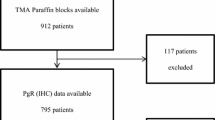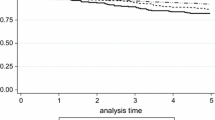Abstract
Background
OncotypeDX® (ODX) is a well-validated assay for breast cancer treatment planning. We explored whether the conventional pathological factors could pick up high risk patients without the help of the ODX.
Methods
The ODX was performed on 139 hormone receptor-positive invasive breast cancers in a single Japanese institution. The recurrence risk was compared between the ODX and the St. Gallen Consensuses. The correlations were analyzed between the Recurrence Score (RS) measured by ODX and the pathological factors. In addition, we performed a follow-up survey and examined the association of the RS with the confirmed recurrence or death.
Results
The ODX classified 68 (49 %) as low RS, 52 (37 %) as intermediate RS, and 19 (14 %) as high RS cases. Correlations were noted between RS and progesterone receptor (PR) (r = −0.53), Ki-67 (r = 0.42), and nuclear grade (NG) (r = 0.41). None had a high RS with PR(3+) or NG1. Only one high RS patient had a Ki-67 (<20 %). The combinations of high RS with PR(0)/Ki-67 (≥20 %) and PR(1+)/Ki-67 (≥20 %) were 70 and 58 %, respectively. The combinations with high RS and PR(0)/NG3, PR(0)/NG2, and PR(1+)/NG3 were 83, 75, and 75 %, respectively. The median follow-up was 39.1 months (range 24.0–67.8). There were one low RS (1 %), four intermediate RS (8 %), and three high RS patients (16 %) who developed local or distant recurrence.
Conclusion
Hormone receptor-positive invasive breast cancers are stratified with the combinations of PR/Ki-67 or PR/NG. Some of the high recurrence risk cases might be identified without the ODX.




Similar content being viewed by others
References
Paik S, Shak S, Tang G, Kim C, Baker J, Cronin M, et al. A multigene assay to predict recurrence of tamoxifen-treated, node-negative breast cancer. N Engl J Med. 2004;351:2817–26.
Perou CM, Sørlie T, Eisen MB, van de Rijn M, Jeffrey SS, Rees CA, et al. Molecular portraits of human breast tumours. Nature. 2000;406:747–52.
Sørlie T, Perou CM, Tibshirani R, Aas T, Geisler S, Johnsen H, et al. Gene expression patterns of breast carcinomas distinguish tumor subclasses with clinical implications. Proc Natl Acad Sci U S A. 2001;98:10869–74.
Parker JS, Mullins M, Cheang MC, Leung S, Voduc D, Vickery T, et al. Supervised risk predictor of breast cancer based on intrinsic subtypes. J Clin Oncol. 2009;27:1160–7.
Carey LA, Dees EC, Sawyer L, Gatti L, Moore DT, Collichio F, et al. The triple negative paradox: primary tumor chemosensitivity of breast cancer subtypes. Clin Cancer Res. 2007;13:2329–34.
Paik S, Tang G, Shak S, Kim C, Baker J, Kim W, et al. Gene expression and benefit of chemotherapy in women with node-negative, estrogen receptor-positive breast cancer. J Clin Oncol. 2006;24:3726–34.
Goldhirsch A, Ingle JN, Gelber RD, Coates AS, Thürlimann B, Senn HJ, et al. Thresholds for therapies: highlights of the St Gallen International Expert Consensus on the primary therapy of early breast cancer. Ann Oncol. 2009;20:1319–29.
NCCN. National Comprehensive Cancer Network Clinical Practice Guidelines in Oncology™. Breast Cancer. 2011; NCCN® Practice Guidelines in Oncology. Version 2.
Harris L, Fritsche H, Mennel R, Norton L, Ravdin P, Taube S, et al. American Society of Clinical Oncology 2007 update of recommendations for the use of tumor markers in breast cancer. J Clin Oncol. 2007;25:5287–312.
Goldhirsch A, Wood WC, Gelber RD, Coates AS, Thürlimann B, Senn HJ. Progress and promise: highlights of the international expert consensus on the primary therapy of early breast cancer 2007. Ann Oncol. 2007;18:1133–44.
Goldhirsch A, Wood WC, Coates AS, Gelber RD, Thürlimann B, Senn HJ, et al. Strategies for subtypes-dealing with the diversity of breast cancer: highlights of the St Gallen International Expert Consensus on the Primary Therapy of Early Breast Cancer 2011. Ann Oncol. 2011;22:1736–47.
Goldhirsch A, Winer EP, Coates AS, Gelber RD, Piccart-Gebhart M, Thürlimann B, et al. Personalizing the treatment of women with early breast cancer: highlights of the St Gallen International Expert Consensus on the Primary Therapy of Early Breast Cancer 2013. Ann Oncol. 2013;24:2206–23.
Cheang MC, Chia SK, Voduc D, Gao D, Leung S, Snider J, et al. Ki67 index, HER2 status, and prognosis of patients with luminal B breast cancer. J Natl Cancer Inst. 2009;101:736–50.
Cuzick J, Dowsett M, Pineda S, Wale C, Salter J, Quinn E, et al. Prognostic value of a combined estrogen receptor, progesterone receptor, Ki-67, and human epidermal growth factor receptor 2 immunohistochemical score and comparison with the Genomic Health Recurrence Score in early breast cancer. J Clin Oncol. 2011;29:4273–8.
Klein ME, Dabbs DJ, Shuai Y, Brufsky AM, Jankowitz R, Puhalla SL, et al. Prediction of the Oncotype DX Recurrence Score: use of pathology-generated equations derived by linear regression analysis. Mod Pathol. 2012;26:658–64.
Ingoldsby H, Webber M, Wall D, Scarrott C, Newell J, Callagy G. Prediction of Oncotype DX and TAILORx risk categories using histopathological and immunohistochemical markers by classification and regression tree (CART) analysis. Breast. 2013;22:879–86.
Cancello G, Maisonneuve P, Rotmensz N, Viale G, Mastropasqua MG, Pruneri G, et al. Progesterone receptor loss identifies luminal B breast cancer subgroups at higher risk of relapse. Ann Oncol. 2013;24:661–8.
Kurebayashi J, Kanomata N, Shimo T, Yamashita T, Aogi K, Nishimura R. Marked lymphovascular invasion, progesterone receptor negativity, and high Ki67 labeling index predict poor outcome in breast cancer patients treated with endocrine therapy alone. Breast Cancer. 2012. doi:10.1007/s12282-012-0380-z.
Prat A, Cheang MC, Martin M, Parker JS, Carrasco E, Caballero R. Prognostic significance of progesterone receptor-positive tumor cells within immunohistochemically defined luminal A breast cancer. J Clin Oncol. 2013;31:203–9.
Cui X, Schiff R, Arpino G, Osborne CK, Lee AV. Biology of progesterone receptor loss in breast cancer and its implications for endocrine therapy. J Clin Oncol. 2005;23:7721–35.
Yerushalmi R, Woods R, Ravdin PM, Hayes MM, Gelmon KA. Ki67 in breast cancer: prognostic and predictive potential. Lancet Oncol. 2010;11:174–83.
Conflict of interest
The authors declare that they have no conflict of interest.
Author information
Authors and Affiliations
Corresponding author
About this article
Cite this article
Onoda, T., Yamauchi, H., Yagata, H. et al. The value of progesterone receptor expression in predicting the Recurrence Score for hormone-receptor positive invasive breast cancer patients. Breast Cancer 22, 406–412 (2015). https://doi.org/10.1007/s12282-013-0495-x
Received:
Accepted:
Published:
Issue Date:
DOI: https://doi.org/10.1007/s12282-013-0495-x




